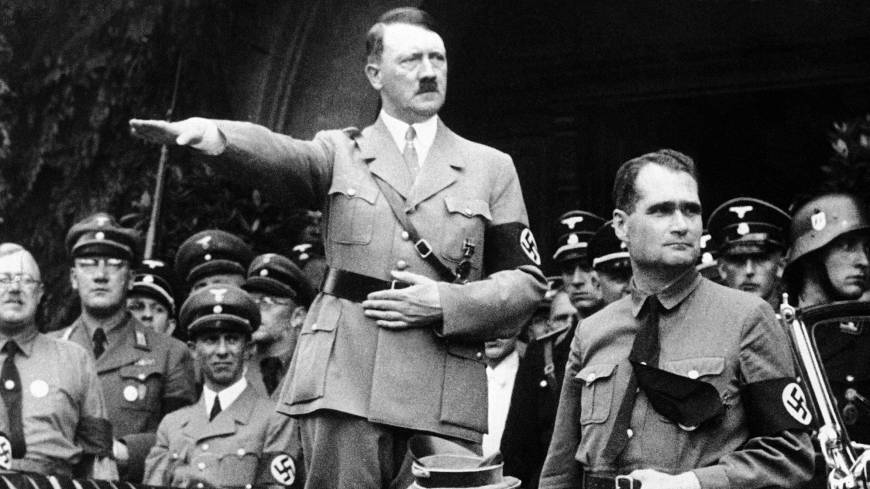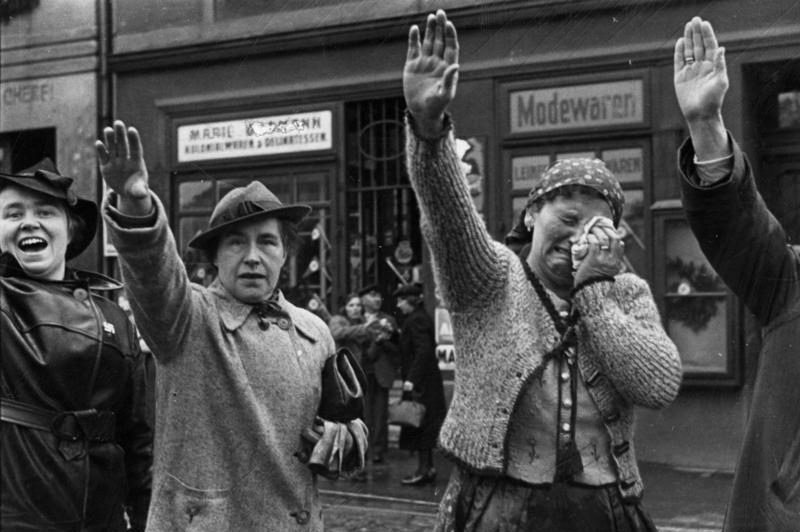The Nazi salute or Hitler salute (German: Hitlergruß – literally Hitler Greeting) is a gesture that was used as a greeting in Nazi Germany. The salute is performed by extending the right arm in the air with a straightened hand. Usually, the person offering the salute would say “Heil Hitler!“ (Hail Hitler!), “Heil, mein Führer!“ (Hail, my leader!), or “Sieg heil!“ (Hail victory!). It was adopted in the 1930s by the Nazi Party to signal obedience to the party’s leader – Adolf Hitler – and to glorify the German nation.The salute was mandatory for civilians but mostly optional for military personnel, who retained the traditional military salute until shortly after the failed assassination attempt on Hitler in 1944.
The salute was performed by extending the right arm to at least eye level, and straightening the hand so that it is parallel to the arm. Usually, an utterance of “Heil Hitler!“, or “Heil!“ accompanied the gesture.
If one saw an acquaintance at a distance, it sufficed to simply raise the right hand. If one encountered a superior, one would also say “Heil Hitler“. If physical disability prevented raising the right arm, it was acceptable to raise the left. The form “Heil, mein Führer!“ was for direct address to Hitler. “Sieg Heil“ was repeated as a chant on public occasions Written communications would be concluded with either mit deutschem Gruß (“with German regards”), or with “Heil Hitler“ In correspondence with high-ranking Nazi officials, letters were usually signed with “Heil Hitler“.
Hitler gave the salute in two ways. When reviewing his troops or crowds he generally used the traditional stiff armed salute. When greeting individuals he used a modified version of the salute, bending his right arm while holding an open hand towards those greeted at shoulder height.
The oral greeting “Heil“ became popular in the pan-German movement around 1900. As a manner of address, Führer was introduced by Georg Ritter von Schönerer, who considered himself leader of the Austrian Germans.
The salute gesture is widely believed to be based on an ancient Roman custom. However, no surviving Roman work of art depicts it, nor does any extant Roman text describe it. Jacques-Louis David’s painting Oath of the Horatii (1784) seems to be the starting point for the gesture that became known as the Roman salute. The gesture and its identification with ancient Rome was advanced in other French neoclassic art.This was further elaborated upon in popular culture during the late 19th and early 20th centuries in plays and films that portrayed the salute as an ancient Roman custom. This included the silent film Cabiria (1914), whose screenplay was written by the Italian ultra-nationalist Gabriele d’Annunzio, arguably the forerunner of Benito Mussolini.In 1919, when he led theoccupation of Fiume, d’Annunzio adopted the style of salute depicted in the film as a neo-Imperialist ritual; and it was quickly adopted by the Italian Fascist Party.

Some party members challenged the legitimacy of the so-called Roman salute, employed by Fascist Italy, as un-Germanic. In response, efforts were made to establish its pedigree by inventing a tradition after the fact. In June 1928, Rudolf Hess published an article titled “The Fascist Greeting”, which claimed that the gesture was used in Germany as early as 1921, before the Nazis had heard about the Italian Fascists.[25] He admits in the article: “The NSDAP’s introduction of the raised-arm greeting approximately two years ago still gets some people’s blood boiling. Its opponents suspect the greeting of being un-Germanic. They accuse it of merely aping the (Italian) Fascists”, but goes on to ask, “and even if the decree from two years ago (Hess’s order that all party members use it) is seen as an adaption of the Fascist gesture, is that really so terrible”? Ian Kershaw points out that Hess did not deny the likely influence from Fascist Italy, even if indeed the salute had been used sporadically in 1921 as Hess claimed.
Today in Germany, Nazi salutes in written form, vocally, and even straight-extending the right arm as a saluting gesture (with or without the phrase), are illegal. It is a criminal offence punishable by up to three years of prison (Strafgesetzbuch section 86a). Usage for art, teaching and science is allowed unless “the existence of an insult results from the form of the utterance or the circumstances under which it occurred”.[ Use of the salute has also been illegal in Austria since the end of World War II.
Usage that is “ironic and clearly critical of the Hitler Greeting” is exempt, which has led to legal debates as to what constitutes ironic use. One recent case involved Prince Albrecht of Hanover, who was brought to court after using the gesture as a commentary on the behavior of an unduly zealous airport baggage inspector. On 23 November 2007, the Amtsgericht Cottbus sentenced Horst Mahler to six months of imprisonment without parole for having, according to his own claims, ironically performed the Hitler salute when reporting to prison for a nine-month term a year earlier. The following month, a pensioner named Roland T was given a prison term of five months for, amongst other things, training his dog Adolf to raise his right paw in a Nazi salute every time the command “Heil Hitler!” was uttered.
Modified versions of the salute are sometimes used by neo-Nazis. One such version is the so-called “Kühnen salute” with extended thumb, index and middle finger, which is also a criminal offence in Germany. In written correspondence, the number 88 is sometimes used by some neo-Nazis as a substitute for “Heil Hitler” (“H” as the eighth letter of the alphabet). Swiss neo-Nazis were reported to use a variant of the Kühnengruss, though extending one’s right arm over their head and extending said three fingers has a different historical source for Switzerland, as the first three Eidgenossen or confederates are often depicted with this motion. Hezbollah supporters in Lebanon often raise their arms in a Nazi-style salute.
On 28 May 2012, BBC current affairs programme Panorama examined the issues of racism, antisemitism and football hooliganism, which it claimed were prevalent among Polish and Ukrainian football supporters. The programme, titled Euro 2012: Stadiums of Hate, included recent footage of Ukrainian supporters giving the Nazi salute and shouting “Sieg Heil”. The two countries hosted the international football competition UEFA Euro 2012.
On 16 March 2013, Greek footballer Giorgos Katidis of AEK Athens F.C. was handed a life ban from the Greek national team for performing the salute after scoring a goal againstVeria F.C. in Athens’ Olympic Stadium.
In April 2014, the Supreme Court of Switzerland ruled that Nazi salutes do not breach hate crime laws if expressed as one’s personal opinion, but only if they are used in attempt to spread its ideology.
On 18 July 2015, The Sun published an image of the British Royal Family from private film shot in 1933 or 1934, showing Elizabeth II (then a young girl) and the Queen Motherboth performing a Nazi salute, accompanied by Edward VIII, taken from 17 seconds of home footage (also released by The Sun). The footage ignited controversy in the UK, and here have been questions as to whether the release of this footage was appropriate. Buckingham Palace described the release of this footage as “disappointing”, and has considered pursuing legal action against The Sun, whereas Stig Abell (managing director of The Sun) said that the footage was “a matter of national historical significance to explore what was going on in the [1930s] ahead of the second world war.
Use of this salute is currently a criminal offense in Germany, the Czech Republic, Slovakia and Austria. In Switzerland and Sweden, the salute is illegal hate speech if used for propagating Nazi ideology
